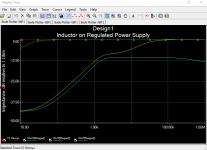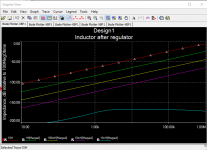Hello friends,
I was crafted audio note like tube regulator for my tubed dac.
Now I consider to use it with my dac and later with line-stage (I gonna build)
What is your opinion on choke regulation? Should I use it before regulator or after regulator. I consider to use 2 chokes 2 regulators, one channel each? Rectification is HV Shottky based bridge.
Once I used 50H choke w/o regulator on my pre and it was not good, feel like less dynamic sound overall. Maybe slow down to much with that big choke. Maybe choke is not a good idea. Hope its not when properly use it.
Opinions welcome!
I was crafted audio note like tube regulator for my tubed dac.
Now I consider to use it with my dac and later with line-stage (I gonna build)
What is your opinion on choke regulation? Should I use it before regulator or after regulator. I consider to use 2 chokes 2 regulators, one channel each? Rectification is HV Shottky based bridge.
Once I used 50H choke w/o regulator on my pre and it was not good, feel like less dynamic sound overall. Maybe slow down to much with that big choke. Maybe choke is not a good idea. Hope its not when properly use it.
Opinions welcome!
In a PSU a properly chosen choke has one of two roles:
1. If before the first reservoir capacitor it helps to regulate the DC, by fixing it to the average of the rectified waveform (apart from resistive losses)
2. Anywhere else it has no regulating function at all, but becomes part of a low pass filter for smoothing ripple.
If you use the wrong value choke in the second position then you can get subsonic resonances in the PSU which might affect the apparent dynamic range of the circuit it feeds, which some people like and others dislike. 'Slowing down' is exactly what a choke is meant to do; that is, it resists changes in current through it - this is how it reduces ripple. The audio signal should not see this, because the choke should not see much of the audio signal because that is handled by whatever capacitor comes after the choke.
1. If before the first reservoir capacitor it helps to regulate the DC, by fixing it to the average of the rectified waveform (apart from resistive losses)
2. Anywhere else it has no regulating function at all, but becomes part of a low pass filter for smoothing ripple.
If you use the wrong value choke in the second position then you can get subsonic resonances in the PSU which might affect the apparent dynamic range of the circuit it feeds, which some people like and others dislike. 'Slowing down' is exactly what a choke is meant to do; that is, it resists changes in current through it - this is how it reduces ripple. The audio signal should not see this, because the choke should not see much of the audio signal because that is handled by whatever capacitor comes after the choke.
Tank you!
according to 1. the only good use of it first before crc and regulator, acting like LCRC than 2 regulators separate left/right channel with no choke after it looks like a safe already good PS design for very good regulation.
PS: In my pre I used CLCRC, with film first cap, and that 50H choke, was not better for me sonically than simple CRC before.
according to 1. the only good use of it first before crc and regulator, acting like LCRC than 2 regulators separate left/right channel with no choke after it looks like a safe already good PS design for very good regulation.
PS: In my pre I used CLCRC, with film first cap, and that 50H choke, was not better for me sonically than simple CRC before.
Last edited:
A choke resonates. A correctly chosen value of choke, sited before the main smoothing capacitor, will help to reduce ripple by utilizing the inductance to counter the pumping action of the feed diodes/rectifier valves.
They were used in the days of valve rectifiers, mainly to reduce the peak current drawn from the rectifier, avoiding damage to the rectifier valve when trying to charge the tank capacitor. They are widely used in gas discharge strip lamps.
RF chokes however have similar characteristics but are only used to remove interference or to tune a circuit.
They were used in the days of valve rectifiers, mainly to reduce the peak current drawn from the rectifier, avoiding damage to the rectifier valve when trying to charge the tank capacitor. They are widely used in gas discharge strip lamps.
RF chokes however have similar characteristics but are only used to remove interference or to tune a circuit.
Last edited:
A PSU has to provide low ripple DC at a low wideband impedance. If it does that then it cannot be improved and does not affect the audio. If it does not do that then it is damaging the audio. If a CRC is good enough then CLCRC will not be better.Hificat said:PS: In my pre I used CLCRC, with film first cap, and that 50H choke, was not better for me sonically than simple CRC before.
Choke resonances are almost always much higher in frequency than ripple, so irrelevant. In a choke input PSU it is the choke inductance which plays the main role, not any choke resonances.JonSnell Electronic said:A choke resonates. A correctly chosen value of choke, sited before the main smoothing capacitor, will help to reduce ripple by utilizing the inductance to counter the pumping action of the feed diodes/rectifier valves.
Opinions welcome!
Unlike many you appear not to be deaf. By using your ears you can save a lot of time and frustration from reading useless opinions.
So let me add mine
First of all not all chokes are created equal. From the readily available ones i really like the Lundahls, as those are wound as proper anode chokes and this is very audible in a PS.
Second, 50H is too large a value and can kill dynamics with its high dcr. It is probably more appropriate for bias supplies.
I use chokes in all high voltage power supplies, usually as input and never above 10H. Downstream there are regulators.
Isn't it something wrong with that graph? 10mH will have at least 62.8 Ohm impedance at 1kHz (or some little more, because of active part of impedance).
1R doesn't cut it, you're right. Relative to 100M:
Attachments
Multisim -- you can do much the same with LTSpice or TINA. Multisim has the benefit of virtual instruments so you don't have to fuss with equations.What software do you are suggest for that simulation?
- Status
- This old topic is closed. If you want to reopen this topic, contact a moderator using the "Report Post" button.
- Home
- Amplifiers
- Power Supplies
- Choke before after regulator

